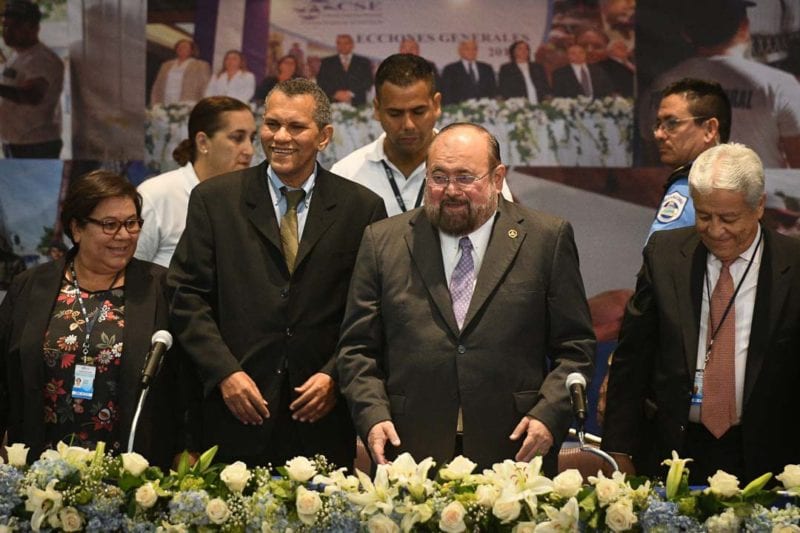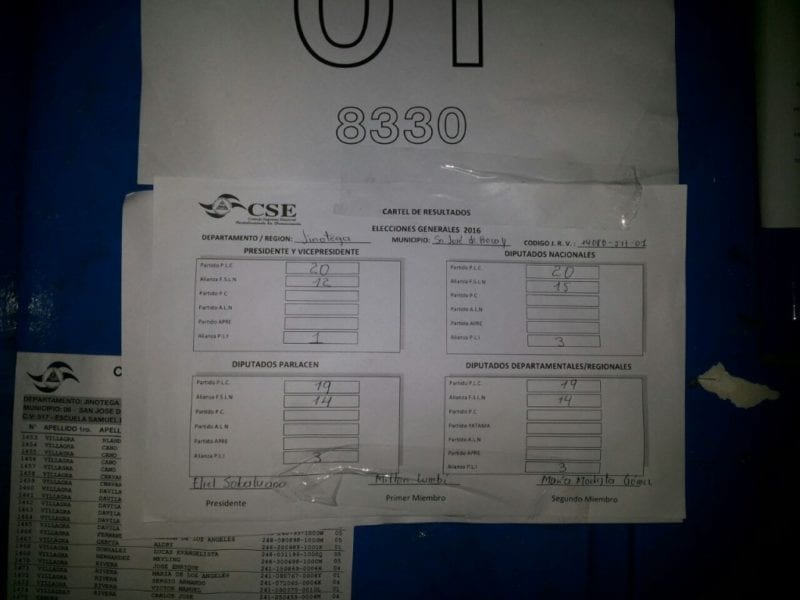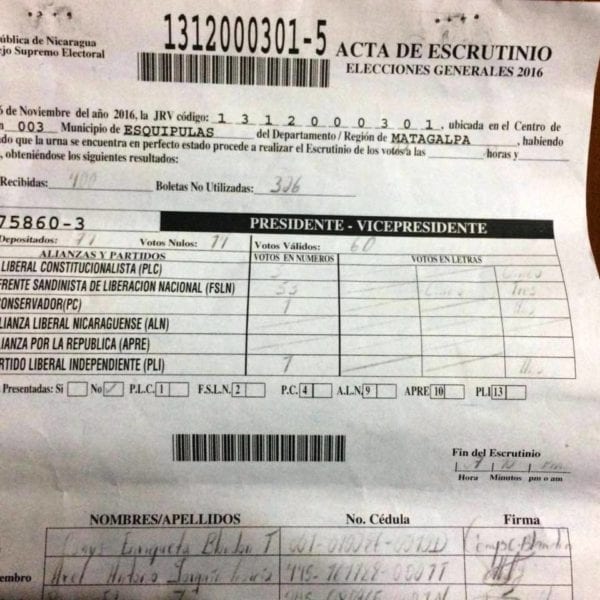Nicaragua’s Supreme Electoral Council “Pretties up” the Abstention
Even with the official statistics, the election participation was lower than that indicated by the Supreme Electoral Council
By Arlen Cerda (Confidencial)

HAVANA TIMES – If two times two are four, Roberto Rivas president of the Supreme Electoral Council (CSE) doesn’t know it. Official data assures that the level of participation in last Sunday’s election was 68.2%. However, even taking these results as a starting point, Rivas’ statistics don’t add up.
Analysts and opposition figures sustain that the erroneous math of the CSE president is the result of premeditated party objectives.
In the morning following the voting, Rivas presented the third preliminary report, with official tallies from 99.8% of the polling places. The official count affirmed that 2,578,445 Nicaraguans left their homes to mark and deposit their vote. “We have a level of participation of 68.2%, Rivas affirmed. Photos taken on election day, as well as the CSE’s own statistics, indicate the opposite.
According to the CSE, the total universe of voters this November 6th was 4,990,020 Nicaraguans. Of them, 4,345,161 citizens were on the “active rolls” – that is, they were apt to vote. Another 644,859 were on the “passive list”, meaning a “cold” list where the electoral register has inscribed some citizens who haven’t voted in the last two or three elections, whatever their motives.
Since 2012, the CSE decided to differentiate these lists with the objective of cleaning out the voting rolls, although four years later they’ve never given an account of the process.
In mid-October, in a report from Confidencial about the FSLN seal on the voting rolls, political analyst José Antonio Peraza warned: “if we don’t have a clear record of the people who are going to vote in a particular polling place, anything could be altered without our ever finding out.”
The 68.2% number doesn’t add up from any direction
With a universe of 4.9 million voters and a total of 2.5 million votes deposited (according to the CSE numbers), a simple calculation reveals an abstention level that’s not 31.8% as the electoral tribunal states, but 48.3%.

That statistic is also six points higher than the 42% abstention registered in the 2011 elections, when Comandante Daniel Ortega imposed his presidential reelection, breaking the chains of the Nicaraguan constitution which prohibited consecutive terms.
If instead of a universe of 4.9 million, we start from the “active voting rolls” of 4.3 million, the percentage of abstention goes down to 40.6%, still nearly nine points above the CSE statistic.
Without offering explanations on the origin of another type of voter roll, in mid-October Magistrate Rivas mentioned that in addition to the total roll, the active roll and the passive roll, there was a “real voter roll” of 3.8 million Nicaraguans which, according to the functionary, is the quantity of voters who would really be called upon to vote.
Even using that “real voter roll” and the quantity of voters that according to the CSE deposited their votes this past November 6th, the percent of abstention is still slightly greater than the number offered.
Are they going to wipe 2.4 million Nicaraguans off the voter rolls?
In their fifth observation report this Monday, the Electoral Panorama consortium highlighted the fact that “the procedure that the Supreme Electoral Council used to clean up the voting roll is unacceptable.”
The mechanism endangers the right to vote of a high percentage of the citizenry who live outside the country or for other reasons haven’t voted in two consecutive elections,” indicated the group that has observed the process without official accreditation, because the government has infringed that right.
In that “clean-up” sifter, effected prior to last Sunday’s vote, the CSE had already dispatched 1.2 million citizens by excluding them from the “real voting roll” which Rivas announced would be his basis for vote counting.
Following November 6th and basing ourselves only on the official results and not on the massive abstention that the CSE is trying to “pretty up” according to the opposition, the number of Nicaraguans excluded under Rivas’ version of the “real voting rolls”, ascends to more than 2.4 million Nicaraguans who haven’t voted in the last two or three elections, including this latest one.
Experts in electoral statistics estimate that a minimal percentage of that number could correspond to deceased Nicaraguans, who still figure on the “active rolls.”
Nonetheless, the great majority corresponds to citizens who haven’t voted in recent elections because they live outside the country, or for varied reasons including apathy, or abstention as a means of protest.
CSE results “not auditable”
Robert Courtney, executive director of Ethics and Transparency and a member of Electoral Panorama, assures that due to the lack of transparency in the process, the voting results presented by the CSE are “not auditable” and can’t be taken as a credible point of reference.

“The 2016 elections haven’t complied with the basic standards of electoral integrity and rather represent a backwards step in comparison with the past three elections that also lacked credibility. Electoral transparency has been eroded, since almost all of the checks and balances that generate confidence have been eliminated,” advised the Electoral Panorama in its report.
The Nicaraguan lawyer and expert in Constitutional Law, Azahálea Solís declared this Monday on the Esta Noche [Tonight] television show that even before the CSE presented the preliminary results and well before the actual voting day, the Nicaraguan electoral process had already lost its legitimacy.
Solis agrees that just as the opposition – outlawed via a legal decision five months before the vote – has stated, the “massive and evident” abstention was a “resounding response from Nicaraguans in reaction to the collapse of the electoral system”.
In the same sense, José Dávila, member of the National Coalition for Democracy, affirms that the level of abstention in the election is greater than the official statistics. He underlined that from the beginning the CSE has “dedicated itself” to “prettying up” the abstention with the use of various data registries.
According to Dávila the monitoring of the observation posts that the National Coalition for Democracy organized indicated an abstention rate between 71 and 74% and that they have copies of the official voting tallies that confirm the tendency towards abstention as well as the manipulation of the tallies by deliberately inflating the number of votes deposited.
With 0.2% of the polling places left to be tallied in the National Data Center, and no explanation from Rivas on the cause of delay, the president of the CSE affirmed yesterday that there won’t be any more press conferences for the preliminary results.
Nonetheless, results by department are still pending, so as to know how many deputies will correspond to each party that appeared on the ballot. The official CSE webpage isn’t a possibility either right now, because it hasn’t yet been brought up to date.
Meanwhile, in zones such as Bilwi (Puerto Cabezas) capital of the North Caribbean Autonomous Region and a bastion of the ethnic Miskito population, the streets seethe with burned tires and protests, because the regional indigenous party Yatama that represents them claims that “once again” the CSE is trying to rob them of a deputy’s seat.





